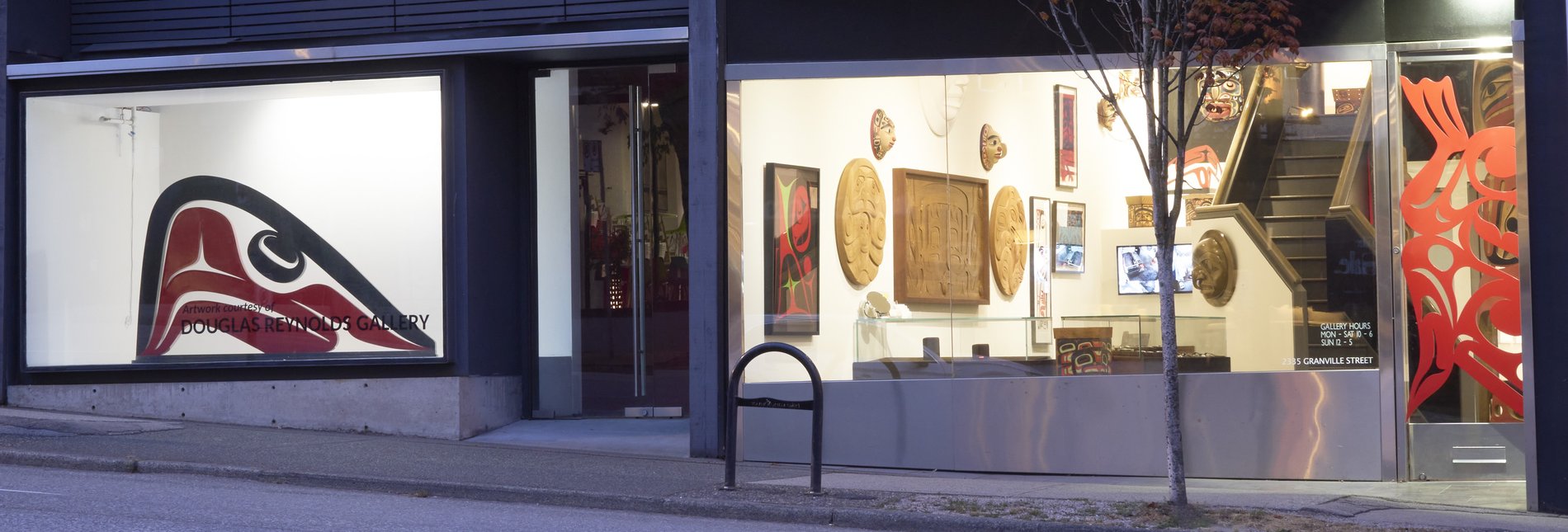It appears that your cart is currently empty
BENTWOOD BOXES

Bentwood boxes are among the most versatile objects made by the Northwest Coast peoples. They were made using an ingenious but difficult technique to master that was specific to the Pacific Northwest region.
Bentwood boxes are unique in that three of their four corners are bent at a 90-degree angle, with the fourth corner being pegged, sewn or glued. The box can then be attached to a base, by pegging, sewing or gluing.
In pre-contact times, when there were no metal tools or nails, this technique proved highly reliable for making strong, long-lasting and watertight containers.
To bend a box, a plank of wood, usually spruce, yellow cedar or red cedar, was cut following the direction of the grain. The spots where the plank is to be bent are kerfed or grooved, then the plank is steamed so that the wood becomes soaked and soft enough not to break when bent. Traditionally, steam was created by putting hot stones from a fire into a water pit.

Bentwood Box
Artist Unknown (Northern Coastal)
ca. 1890
Red Cedar & Pigment
27″ H x 17″ D x 21 W
HISTORICAL
Bentwood boxes had numerous uses on the Northwest Coast, among them oil and food dishes, storage boxes for food or ceremonial regalia, water buckets, burial boxes, box rattles, canoe tackle boxes, and drum boxes. They were also used to steam food by filling the box with water and dropping stones from a fire into the box.
Bentwood dishes, chests, and crates were highly valued goods, often carved, painted, or both. Some of them represent crests owned by chiefly families and are objects of bright pride. The design on many historic boxes tend to be abstract, not forming any singular crest figure.

Bulging Bowl
Artist Unknown (Haida)
ca. 1870
Red Cedar & Pigment
19″ H x 14 1⁄2" W x 9″ D
Bentwood Bowl
Artist Unknown (Tlingit)
Early to Mid-19th Century
Maple, Red Cedar & Operculum
5 1⁄4″ H x 9 1⁄4″ W x 10 3⁄4″ L
Bentwood boxes had numerous uses on the Northwest Coast, among them oil and food dishes, storage boxes for food or ceremonial regalia, water buckets, burial boxes, box rattles, canoe tackle boxes, and drum boxes. They were also used to steam food by filling the box with water and dropping stones from a fire into the box.
Bentwood dishes, chests and crates were highly valued goods, often carved, painted, or both. Some of them represent crests owned by chiefly families and are objects of bright pride. The design on many historic boxes tend to be abstracts, not forming any singular crest figure.
CONTEMPORARY

Transformation Bentwood Bowl
Joshua Prescott-Shaw (Cree)
Yellow Cedar, Red Cedar & Abalone
8″ H x 10 1⁄4″ W x 10 1⁄2″ D

Raven Bentwood Box
Robert Mills (Tlingit)
Hand Carved and Painted Red Cedar
14″ H x 15″ W x 19″ L
Boxes made for inter-tribal trade usually had more abstracted designs rather than crest figures which were used and owned by specific groups. Among the most exceptional bentwood boxes are canoe tackle boxes, bulging bowls, and twelve-sided boxes. These reveal the mastery and ingenuity of the artist who produced them.
Canoe boxes are interesting because the artist is bending the wood off the right angle which not only shows a level of expertise the shape works well for wedging into the front of a canoe. The last two works by Rod Smith take the idea of the traditional bent and canoe box and are painted with an abstract North West Coast design. The artist is inspired by the abstraction of historic bent boxes but represents his art in a contemporary design.

Eagles Bentwood Box
Joslyn Williams (Nuu-chah-nulth)
Red Cedar & Acrylic
16″ H x 8 3⁄4″ W x 8 3⁄4″ D

Canoe Bentwood Box
Rod Smith (Kwakwaka’wakw)
Red Cedar & Acrylic
10″ H x 9 1⁄2″ W x 13 1⁄2″ D

Bentwood Box
Rod Smith (Kwakwaka’wakw)
Hand Carved Red Cedar, Yellow Cedar & Acrylic
8″ H x 6″ W x 6″ D
POINTS TO PONDER
When compiling this newsletter, we referenced ‘Cedar’ by Hilary Stewart. In it, she talks about how bentboxes were used by most people for various reasons. A urinal box by the door of a house protected the inhabitants from ghosts and malicious spirits who were repulsed by the bodily fluid. Shaman would carry mystical paraphernalia, a fisherman brought his gear, domestic boxes housed dried foods, a water box was used for travelling long distances. At a potlach, the magnificent boxes that were made for wealthy chiefs, were set out in a display of opulence to validate wealth and status of the household. These boxes were passed down through the generations.
Boxes were also used for burial purposes. When a person died, the body would be folded to fit into the box with their head being placed in the corner where the steambent plank was joined. This allowed the soul to escape through the crack. Boxes were then placed in a variety of locations including a gravehouse, mortuary pole, even in the tops of trees that leaned over water. High ranking families would place the burial boxes in family owned caves, above high tide.
Although many artists makes their own boxes, some artists hire bentbox makers to make a blank box for them to carve and paint. Sometimes the maker is acknowledged, other times not. Larry Rosso (now deceased) was one of the great contemporary bentbox makers and he often would charge artists the cost of the wood to make a box. If you wanted a Rosso box you’d give him two boards of wood and he would make two boxes keeping one for himself to carve.



0 comments